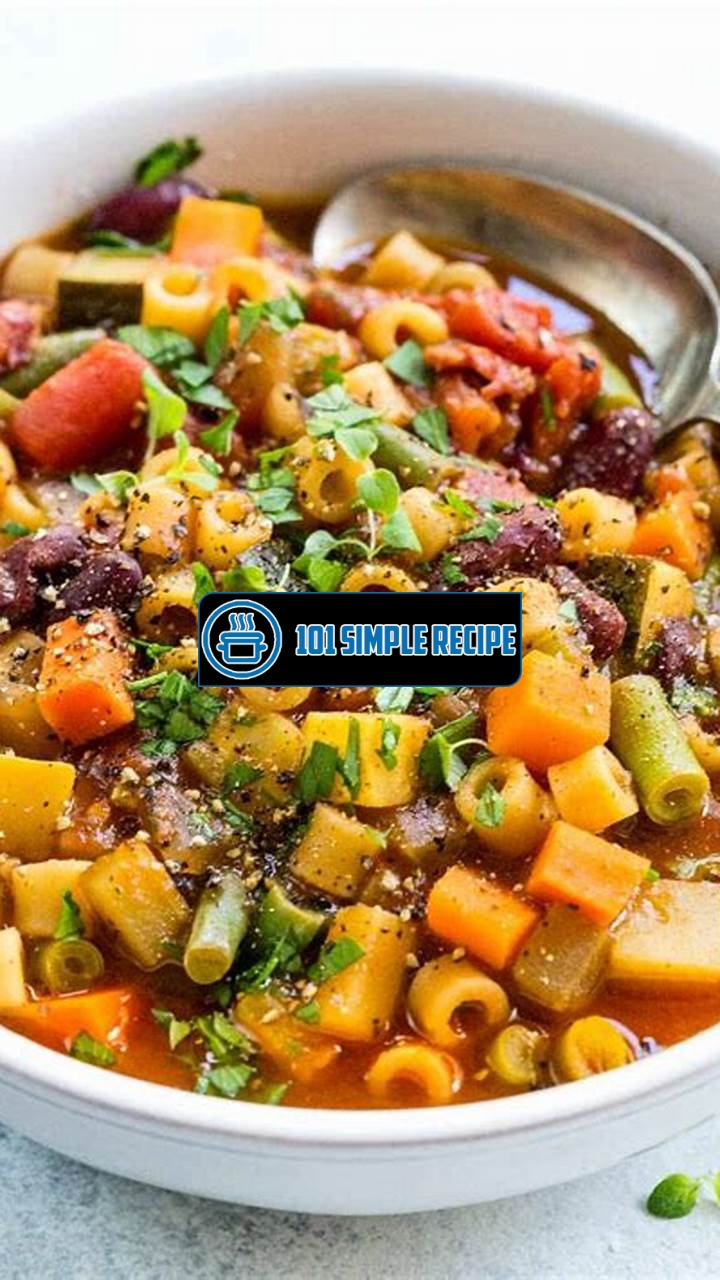If you’re looking to enjoy a heartwarming and nutritious meal at home, look no further than this incredible minestrone soup recipe. Packed with fresh vegetables, savory herbs, and wholesome ingredients, this soup is sure to satisfy your taste buds and leave you feeling satisfied. Whether you’re a seasoned chef or a novice in the kitchen, this recipe is easy to follow and guarantees delicious results every time. Get ready to dive into a bowl of comforting goodness that will warm your soul on even the coldest of days. ️

The History of Minestrone Soup
Discover the origins and evolution of minestrone soup, a classic Italian dish beloved worldwide.
The Origins of Minestrone Soup
Minestrone soup has a long and rich history that dates back to ancient times. It is believed to have originated in the Mediterranean region, specifically in Italy, where it has been a staple dish for centuries. The word “minestrone” itself is derived from the Italian word “minestra,” which means “soup.”
Minestrone soup was initially created as a way to make use of leftover vegetables and pantry staples. It was a simple peasant dish, made with whatever ingredients were readily available. The soup would typically consist of a flavorful broth, vegetables like tomatoes, onions, carrots, celery, and beans, as well as pasta or rice for added sustenance.
Over time, the recipe for minestrone soup evolved as different regions and households added their own twist to the dish. Each variation brought its unique flavors and ingredients, making minestrone soup a versatile and customizable dish.
Evolution and Variations of Minestrone Soup
As minestrone soup gained popularity, it started to appear in different regions of Italy and beyond. Each region added its own local ingredients and cooking traditions to create variations of the classic dish. For example, in Northern Italy, minestrone soup is often made with a base of beef or chicken broth, while in Southern Italy, vegetable broth is the preferred choice.
In addition to the variation in broths, the vegetables used in minestrone soup can vary depending on the season and availability. Some popular additions include zucchini, cabbage, potatoes, and leafy greens like spinach or kale. Herbs and spices like basil, oregano, and thyme are also commonly used to enhance the flavor profile.
Another notable variation is the addition of meat or protein. While traditional minestrone soup was primarily a vegetarian dish, modern versions often include bacon, pancetta, or sausage for added depth of flavor. This adaptation appeals to meat lovers and adds another layer of richness to the dish.
Why Minestrone Soup Stands the Test of Time
Minestrone soup has stood the test of time for several reasons. Firstly, it is a highly nutritious and satisfying dish. Packed with an abundance of vegetables, beans, and sometimes pasta or rice, it provides a balanced combination of carbohydrates, proteins, and vitamins.
The versatility of minestrone soup is also a significant factor in its enduring popularity. This dish can be easily adapted to suit different dietary preferences and restrictions. Whether you’re a vegetarian, vegan, or following a gluten-free diet, you can tailor the ingredients to meet your needs without compromising on taste.
Lastly, minestrone soup is a comforting and soul-warming dish that brings people together. It is often enjoyed during cold winter months or as a hearty meal to share with family and friends. The act of preparing and savoring a bowl of minestrone soup can evoke feelings of nostalgia and create a sense of community.
For other soup recipes, try our weight loss recipe that is both nutritious and delicious.
Choosing the Right Ingredients for the Perfect Minestrone Soup
When it comes to making a delicious and nutritious minestrone soup, choosing the right ingredients is key. Each component plays a crucial role in creating a flavorful and satisfying dish that you and your family will love. In this section, we will explore the essential ingredients that make a minestrone soup truly exceptional.
The Base: Broth or Tomato?
The base of minestrone soup sets the foundation for its rich and comforting flavors. Traditionally, there are two options to consider: broth or tomato. Both choices have their distinct qualities, so it ultimately depends on your personal preference.
If you opt for a broth base, it provides a lighter and more delicate flavor profile. Vegetable or chicken broth works well here, adding depth to the soup without overpowering the other ingredients. This option allows the flavors of the vegetables and proteins to shine through, creating a well-balanced and refreshing soup.
On the other hand, using a tomato base adds a tangy and robust dimension to the minestrone soup. The natural acidity of tomatoes pairs perfectly with the hearty ingredients often found in minestrone, such as beans and pasta. The tomato base also brings a beautiful red color to the soup, making it visually appealing and appetizing.
Vegetables: A Variety of Colors and Flavors
When it comes to vegetables in minestrone soup, the more, the merrier. This hearty soup offers an excellent opportunity to pack in a variety of colors, flavors, and nutrients. Here are some essential vegetables to consider:
- Carrots: These vibrant orange veggies add sweetness and a subtle crunch to the soup. They are also a great source of beta-carotene and fiber.
- Celery: With its refreshing taste and crisp texture, celery is a staple in many minestrone recipes. It provides a gentle earthy flavor and contributes to the overall aroma of the soup.
- Zucchini: Adding zucchini brings a mild and slightly sweet taste, along with a pleasant texture. It also contributes to the soup’s overall heartiness.
- Spinach: This leafy green vegetable wilts in the hot broth, adding a burst of vibrant color and essential nutrients like iron and vitamin C.
- Tomatoes: If you didn’t choose a tomato base for your soup, adding fresh or canned tomatoes can enhance the flavor and tanginess.
Feel free to experiment with other vegetables based on your preferences and what’s in season. The key is to create a medley of flavors and textures that complement each other harmoniously.
Protein and Carbohydrates: Adding Texture and Sustenance
Minestrone soup is often made heartier by incorporating sources of protein and carbohydrates. These ingredients not only contribute to the soup’s texture but also provide sustenance to keep you satisfied. Here are some key additions:
Beans: Whether you choose kidney beans, cannellini beans, or a combination, they are a perfect protein-packed addition. Beans add creaminess and body to the soup, making each spoonful more satisfying.
Pasta: Including small pasta shapes, like macaroni or ditalini, is a classic choice for minestrone soup. The pasta cooks directly in the broth, absorbing the flavors and giving the soup a delightful al dente texture.
Protein of choice: Consider adding cooked chicken, beef, or sausage to your minestrone soup for an extra layer of flavor and protein. This is a great way to use up leftover cooked meats.
By balancing the protein and carbohydrate components of your minestrone soup, you ensure a well-rounded and satisfying meal that will keep you coming back for more.
Remember, the beauty of minestrone soup lies in its versatility. Feel free to experiment with different combinations of ingredients, herbs, and spices to create your unique take on this beloved Italian soup. Enjoy a delicious and healthy bowl of minestrone soup, and bon appétit!Secrets to Enhance the Flavor of Minestrone Soup
Discover expert tips and tricks to take your minestrone soup to the next level in terms of taste. In this article, we will delve into the secrets that will help you create a truly delicious and flavorful minestrone soup. From harnessing the power of herbs and spices to creating depth with stocks and bouillons, and accentuating with parmesan rinds and cheese, these techniques will elevate your minestrone soup to new heights of culinary delight.
The Power of Herbs and Spices
When it comes to enhancing the flavor of any dish, herbs and spices are the secret weapons that can bring out the best in your minestrone soup. By using a combination of fresh and dried herbs, you can create a complex and aromatic flavor profile that will tantalize your taste buds. Some of the key herbs and spices that work well in minestrone soup include:
- Basil: This herb adds a fresh and slightly sweet flavor to the soup.
- Oregano: Oregano brings a touch of warmth and earthiness to the dish.
- Thyme: Thyme adds a subtle floral note and enhances the overall aroma of the soup.
- Bay leaves: Bay leaves impart a rich and fragrant taste to the soup.
- Red pepper flakes: For those who like a bit of heat, red pepper flakes can add a spicy kick to the soup.
Note: Experiment with different combinations of herbs and spices to find the perfect flavor balance for your minestrone soup.
Creating Depth with Stocks and Bouillons
To create a rich and flavorful base for your minestrone soup, it is important to use high-quality stocks and bouillons. These ingredients serve as the foundation upon which all the flavors of the soup will be built. Opt for homemade stocks or bouillons whenever possible, as they can add a depth of flavor that store-bought versions may lack. Alternatively, you can enhance store-bought stocks by simmering them with additional ingredients such as onions, carrots, and celery to infuse them with more flavors.
Note: Be sure to taste and adjust the seasoning of your soup accordingly, as stocks and bouillons can vary in their saltiness.
Accentuate with Parmesan Rinds and Cheese
One of the secrets to giving your minestrone soup a rich and savory flavor is to add parmesan rinds during the cooking process. Parmesan rinds are the hardened outer layer of the cheese, and they contain an intense flavor that can infuse your soup with a delightful umami taste. Simply add the parmesan rinds to the pot while the soup is simmering, and remove them before serving.
Additionally, topping your minestrone soup with grated parmesan cheese can add an extra layer of creaminess and depth to the dish. The sharp and nutty flavor of parmesan complements the other ingredients in the soup perfectly.
Note: Freshly grated parmesan cheese is always recommended for the best flavor.
With these expert tips and tricks, you now have the knowledge to create a minestrone soup that is bursting with flavor. By harnessing the power of herbs and spices, creating depth with stocks and bouillons, and accentuating with parmesan rinds and cheese, your minestrone soup will become a crowd-pleasing favorite in your home. Enjoy the hearty and delicious flavors that this classic Italian soup has to offer!
If you’re looking for more delicious recipes, check out our best minestrone soup recipe for a hearty and comforting meal.
Cooking Techniques for a Perfect Minestrone Soup
Mastering the cooking techniques is essential to ensure that your minestrone soup turns out perfect every single time. Whether you prefer sautéing or boiling, knowing when to add each ingredient, or finding the right consistency through simmering or serving, these techniques will take your minestrone soup to the next level.
Sautéing versus Boiling: Which is Better?
When it comes to cooking minestrone soup, the debate between sautéing and boiling is a common one. Sautéing involves cooking the vegetables in oil or butter until they are lightly browned and tender. This method brings out the flavors and creates a rich base for your soup. On the other hand, boiling involves cooking the vegetables in a pot of boiling water until they are soft. While this is a simpler method, it may result in a slightly different flavor and texture. So, which one is better? It ultimately depends on your personal preference. If you enjoy a deeper and more complex flavor, sautéing is the way to go. However, if you prefer a lighter and fresher taste, boiling the vegetables will work just fine.
The Timing: When to Add Each Ingredient
The key to a well-balanced minestrone soup lies in knowing when to add each ingredient. Start by sautéing your aromatic ingredients, such as onions, garlic, and carrots, to build a flavorful base. Once they are fragrant and slightly softened, it’s time to add the rest of the vegetables, such as zucchini, celery, and tomatoes. These veggies require less cooking time and add a refreshing crunch to your soup. To enhance the flavors, add herbs and spices like basil, oregano, and thyme. Finally, for a protein-packed soup, add cooked beans, such as cannellini or kidney beans. They can be added towards the end of the cooking time to avoid overcooking. By following this timing guide, each ingredient will be perfectly cooked and contribute to the overall deliciousness of your minestrone soup.
Simmering vs. Serving: Finding the Right Consistency
Choosing between simmering and serving your minestrone soup depends on the consistency you desire. Simmering your soup allows the flavors to meld together and results in a thicker, heartier consistency. This method is perfect for those who enjoy a more substantial meal. On the other hand, if you prefer a lighter and brothy consistency, serve the soup as soon as it is cooked. This will retain the freshness of the vegetables and provide a lighter and more refreshing experience. Experiment with both methods to find the perfect consistency that suits your taste buds.
Mastering the cooking techniques for minestrone soup is key to achieving a delicious and healthy home-cooked meal. Sautéing or boiling your vegetables, understanding the timing for adding each ingredient, and choosing between simmering or serving will all contribute to a satisfying bowl of minestrone soup. So, roll up your sleeves, grab your apron, and get ready to create a minestrone masterpiece in your very own kitchen!
Serving and Pairing Suggestions for Your Minestrone Soup
When it comes to serving and enjoying your delicious and healthy minestrone soup, there are plenty of creative ways to elevate the experience. From garnishes and toppings to complementary dishes and beverage pairings, let’s explore how you can make the most of your homemade soup.
Garnishes and Toppings to Elevate the Presentation
To take your minestrone soup to the next level, consider adding some thoughtfully chosen garnishes and toppings. These not only enhance the visual appeal but also add layers of flavor and texture to your dish.
- Fresh Herbs: A sprinkle of fresh basil or parsley adds a pop of color and an herby aroma to your soup.
- Grated Parmesan: A generous sprinkle of grated Parmesan cheese adds a creamy and savory finish.
- Crunchy Croutons: Homemade or store-bought croutons provide a satisfying crunch that contrasts with the tender vegetables and beans in your soup.
- Drizzle of Olive Oil: A drizzle of extra virgin olive oil creates a silky texture and adds a fruity note.
Accompaniments: What to Serve with Minestrone Soup
While minestrone soup is a hearty and satisfying dish on its own, serving it with complementary dishes can turn it into a complete and wholesome meal. Here are some ideas to consider:
- Crusty Bread: A slice of warm, crusty bread is the perfect accompaniment for dipping into your soup.
- Salad: A fresh green salad with a tangy vinaigrette provides a refreshing contrast to the rich flavors of your minestrone soup.
- Italian Antipasto Platter: Create a rustic spread of cured meats, cheeses, olives, and marinated vegetables for a satisfying and diverse dining experience.
- Grilled Cheese Sandwich: A classic grilled cheese sandwich with gooey melted cheese is a comforting and delicious pairing.
Beverage Pairings: Finding the Perfect Match
Pairing the right beverage with your minestrone soup can elevate the overall dining experience. Here are some suggestions to consider:
- Red Wine: A medium-bodied red wine, such as a Chianti or a Sangiovese, complements the rich flavors of the soup.
- Herbal Tea: A cup of herbal tea, such as chamomile or peppermint, provides a soothing and refreshing balance.
- Sparkling Water: For a lighter option, try pairing your soup with some refreshing sparkling water infused with a squeeze of lemon or a splash of cranberry juice.
- Vegetable Broth: If you prefer a non-alcoholic option, a warm cup of vegetable broth enhances the flavors and provides a hydrating accompaniment.
By exploring creative ways to present and enjoy your minestrone soup, along with carefully selected garnishes, complementary dishes, and beverage pairings, you can truly create a delightful and memorable dining experience. So, go ahead and let your culinary creativity shine!
If you’re in the mood for something refreshing, our punch bowl recipe will surely quench your thirst.
Thank you for taking the time to read our article on the best minestrone soup recipe. We hope you found it informative and inspiring for your future cooking endeavors. If you’re craving a delicious and hearty bowl of minestrone soup, we encourage you to bookmark this page and visit again later for more amazing recipes.
Frequently Asked Questions
Here are some frequently asked questions about minestrone soup:
| No. | Questions | Answers |
|---|---|---|
| 1. | What vegetables can I add to my minestrone soup? | You can add a variety of vegetables to your minestrone soup, such as carrots, celery, tomatoes, zucchini, and beans. Feel free to experiment with different combinations to suit your taste. |
| 2. | Can I make minestrone soup ahead of time? | Absolutely! Minestrone soup is a great dish to make ahead of time. You can store it in the refrigerator for up to three days or freeze it for longer storage. Just reheat it gently on the stovetop before serving. |
| 3. | Is minestrone soup vegetarian-friendly? | Yes, minestrone soup can be made vegetarian-friendly by using vegetable broth instead of meat-based broth. You can also omit meat and add more vegetables or beans for protein. |
| 4. | Can I make minestrone soup in a slow cooker? | Certainly! Minestrone soup can be made in a slow cooker for a convenient and hands-off cooking experience. Just follow the recipe instructions, but adjust the cooking time to fit your slow cooker’s settings. |
| 5. | What type of pasta is best for minestrone soup? | Small pasta shapes like macaroni, ditalini, or small shells work well in minestrone soup. They add a nice texture and are easy to eat with a spoon. |
| 6. | Can I customize the seasonings in minestrone soup? | Absolutely! You can customize the seasonings in minestrone soup to your liking. Add herbs like basil, oregano, or thyme for extra flavor. Don’t forget to taste and adjust the seasonings as you go. |
Closing Thoughts
We hope this article has provided you with a fantastic minestrone soup recipe. Whether you’re making it for a cozy dinner at home or for a gathering with friends, this hearty and flavorful soup is sure to delight. Remember to bookmark this page and revisit for more amazing recipes. Happy cooking!
Jump to Recipe
Best Minestrone Soup Recipe

Discover how to make the best minestrone soup with this delicious recipe. Packed with vegetables, beans, and pasta, this hearty soup is sure to satisfy.
- 1 tablespoon olive oil
- 1 onion (diced)
- 2 carrots (sliced)
- 2 stalks celery (diced)
- 2 cloves garlic (minced)
- 1 can diced tomatoes
- 4 cups vegetable broth
- 1 cup water
- 1 teaspoon dried oregano
- 1 teaspoon dried basil
- 1 bay leaf
- 1 cup small pasta shells
- 1 can kidney beans (drained and rinsed)
- 1 cup frozen green beans
- Salt and pepper to taste
- Heat the olive oil in a large pot over medium heat. Add the onion, carrots, celery, and garlic. Cook until the vegetables are tender, about 5 minutes.
- Add the diced tomatoes, vegetable broth, water, oregano, basil, and bay leaf. Bring to a boil, then reduce heat and simmer for 30 minutes.
- Add the pasta shells, kidney beans, and frozen green beans. Cook for an additional 10-15 minutes, or until the pasta is tender.
- Season with salt and pepper to taste. Remove the bay leaf before serving.
- Serve hot and enjoy!






